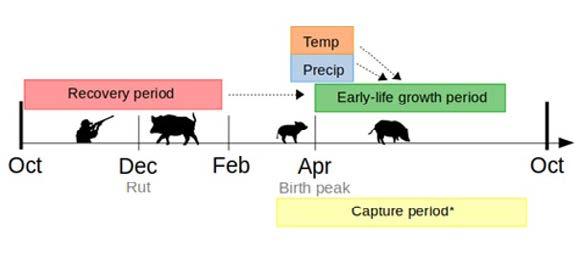
62 minute read
Scientific Activity
researCh group: synThesis
Current group members: PI: Professor Bernt-Erik Sæther Professor Cameron Ghalambor Researcher Marlène Gamelon Postdoc Hannah Froy Postdoc Rémi Fay Postdoc Thomas Kvalnes PhD candidate Lara Veylit PhD candidate Stefan Vriend
Advertisement
Aim: To apply stochastic models to understand processes affecting the dynamics of populations and phenotypes in fluctuating environments.
Major sCientifiC ContriButions
Bernt-Erik Sæther, Cameron Ghalambor Marlène Gamelon, Hannah Froy, Rémi Fay, Thomas Kvalnes, Lara Veylit, Stefan Vriend
Two important events involved members of this RG in 2020. Researcher Marlene Gamelon was from October 1 appointed as permanent researcher at CNRS, France. However, she will still keep 20 % of her position at CBD until the end of the center period. In addition, postdoc Hannah Froy was awarded a University Research Fellowship (URF) from The Royal Society of London for the project Eco-evolutionary consequences of individual heterogeneity in density dependence.
The ecology and demography of wild boar
In November, Lara Veylit submitted her PhD thesis, entitled Causes and consequences of body growth variation in hunted wild boar populations, under the supervision of Bernt-Erik Sæther and Marlène Gamelon. She focused her research on “growth”, a particularly interesting (and poorly studied) life-history trait linked to body size in adulthood, reproductive success, and longevity. Her main objective was to understand why body growth varies among populations and between individuals and the consequences of this variation. To reach this goal, she took advantage of data from individual long-term monitoring studies of wild boar Sus scrofa in France. This is an emblematic game species, living in different habitats, offering the opportunity to compare body growth patterns across contrasting environments in terms of habitat quality and hunting pressures. First, she estimated body growth early in life (until about 6 months of age) in different populations and assessed the effects of temperature, precipitations and density at birth on early-life growth (Figure 1).
Figure 1.Wild boar life cycle. Data on the number of removed individuals are collected during the hunting season (October-February) coinciding with the rut and gestation periods. Weather variables (temperature and precipitation) that influence early-life growth rates were collected during the birth peak, in April, and the period of early-life growth coincides with the capture period (which may vary slightly between sites) (from Veylit et al. 2020a).
Figure 2. Age-specific hunting mortality (P(Mh) in A and C panels) and natural mortality (P(Mn) in B and D panels) as a function of early-life growth rate (in g/day) for male (A and B panels) and female (C and D panels) wild boar in Châteauvillain in France. The points depict the mortality estimates and 95% confidence intervals from a model for each class of early-life growth rates included as a categorical variable. The lines correspond to mortality estimates for each age class included in the selected models with early-life growth rate as a continuous variable and associated 95% confidence intervals. The rug plot shows the distributions of early-life growth rates for each sex. The stars depict age-specific mortality estimates from models with either negative to zero early-life growth rates or positive early-life growth rates. The estimates from the categorical models are plotted against the median value in the range of early-life growth rates for a given bin (from Veylit et al. 2020b).
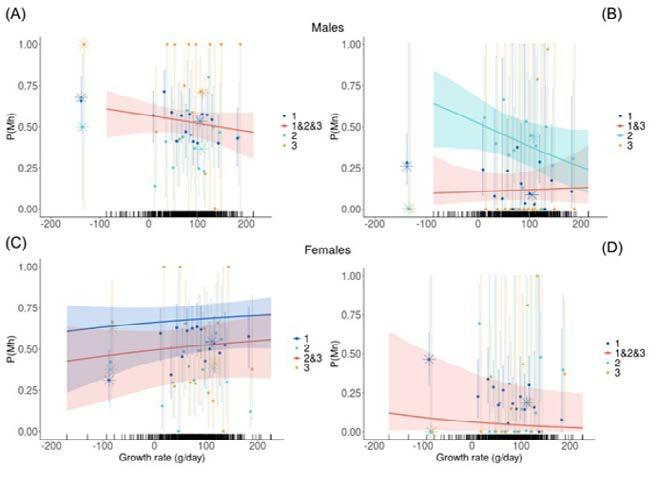
Figure 3. Body growth trajectories of wild boar in two localitets in France (Châteauvillain (first row) and Chizé (second row) ), for males (panels A, D) and females (panels B, E). Points depict observations with matching colors of individual growth curves, from the selected models. Panels C and F show asymptotic body mass A according to birth year for both sexes (i.e. cohort effect on A).
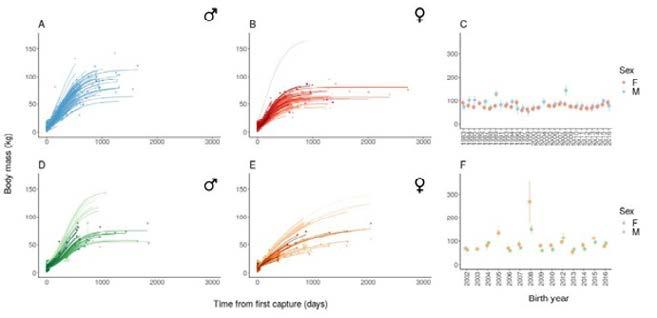
Veylit found high variation in body growth rates across time, mainly driven by spring temperatures at birth with warmer spring favoring faster growth (Veylit et al. 2020a). Then, she empirically tested the well-known trade-off between growth and survival, by investigating whether fast early-life growth entailed a survival cost. She did not find evidence for this type of cost in the studied population (Figure 2) which is heavily hunted, the short lifespan of the individuals potentially masking long-term costs (Veylit et al. 2020b).
Then, Veylit broadened her focus to growth throughout the entire lifetime of an individual (i.e. not only early-life growth) to quantify growth trajectories across populations in contrasting environments using growth functions that encompass the expected range of growth shapes. She found context-dependent body growth (Figure 3); the shape of body growth varied between environments, sexes, and across individuals (Veylit et al. in revision).
Finally, Veylit assessed the role of acorns, an important food resource, on the probability for a female to move from a given body mass class to another within a year (i.e. growth transitions) and the consequences for the population dynamics. She found that acorn availability positively influences body growth, involving faster population growth rates in the studied populations (Gamelon et al. in press).
While having a focus on wild boar as a case study, Veylit’s thesis improves our general knowledge on the causes and consequences of body growth variation in the wild.
Natural environments vary on multiple scales, which affects ecological and evolutionary processes of wild populations. Under long periods of evolutionary stasis, stabilizing selection is thought to be the most important mechanism that counteracts phenotypic changes by genetic drift and mutations. Few if any traits are free to evolve independently of other traits, instead selection may act on multiple traits that interact to create a combined phenotype. Correlational selection may then be an important process driving adaptive evolution, such that knowledge of the selective surface for combinations of genetically correlated traits become vital to predict how population mean phenotypes and fitness are affected when environments change. In semi-domestic reindeer in northern Finland, Holand et al. (2020) have shown that there is directional and stabilizing selection toward a combination of earlier birth date and heavier birth mass with an intermediate optimum along the major axis of the selection surface (Figure 4). In addition, there was found changes in the means towards earlier birth and heavier birth mass that were congruent with the direction of selection, and corresponding genetic changes in breeding values.
Most of the theory underlying predictions of responses to selection assumes a moving optimum phenotype, with predictions expressed in terms of the temporal variance and autocorrelation of this optimum. Phenological events, like timing of reproduction, are among the traits that are most sensitive to fluctuations and temporal changes in environmental conditions. In a meta-analysis, de Villemereuil et al. (2020) in collaboration with several people at CBD (Gamelon, Kvalnes and Tufto) investigated the extent of temporal variation in selection on breeding date in 39 populations of 21 species of birds and mammals. Breeding date can easily be compared across species and an optimum is likely because reproducing either too early or too late should limit reproductive success (including offspring survival). The study found support for a fitness function with a fluctuating optimum that caused temporal variation in the magnitude, but not the direction of selection. Birds and mammals displayed quite similar patterns, but mammals tended to display larger temporal variation in the optimum and selection. In addition, for several data sets there was clear evidence for phenotypic tracking of the optimum by plastic responses of individuals that reproduce in consecutive years. The signal of phenotypic tracking by plasticity was strongest in birds.
RECOMMENDED READING:
de Villemereuil, P., Charmantier, A., Arlt, D., Bize, P., Brekke, P., Brouwer, L., Cockburn, A., Côté, S., Dobson, F.S., Evans, S.R., Festa-Bianchet, M., Gamelon, M., Hamel, S., Hegelbach, J., Jerstad, K., Kempenaers, B., Kruuk, L.E.B., Kumpula, J., Kvalnes, T., McAdam, A.G., McFarlane, S.E., Morrissey, M.B., Pärt, T., Pemberton, J.M., Qvarnström, A., Røstad, O.W., Schroeder, J., Senar, J.C., Sheldon, B.C., Van de Pol, M., Visser, M.E., Wheelwright, N.T., Tufto, J., Chevin, L.-M. 2020. Fluctuating optimum and temporally variable selection on breeding date in birds and mammals. Proceedings of the National Academy of Sciences of the United States of America, 117, 31969-31978. doi: 10.1073/pnas.2009003117 Gamelon, M., L. Touzot, É. Baubet, J. Cachelou, S. Focardi, B. Franzetti, E. Nivois, L. Veylit, and B.-E. Saether. in press. Effects of pulsed resources on the dynamics of seed consumer populations: A comparative demographic study in wild boar.
Ecosphere. Holand, H., Kvalnes, T., Røed, K.H., Holand, Ø., Sæther, B.-E., Kumpula, J. 2020. Stabilizing selection and adaptive evolution in a combination of two traits in an arctic ungulate. Evolution: 74, 103-115. doi:10.1111/evo.13894 Veylit, L., B.-E. Saether, J.-M. Gaillard, É. Baubet, and M. Gamelon. in revision. Evidence for context-, sex- and cohort-specific lifetime growth in a wild mammal. Veylit, L., B.-E. Sæther, J.-M. Gaillard, E. Baubet, and M. Gamelon. 2020a. How do conditions at birth influence early-life growth rates in wild boar? Ecosphere 11:e03167. Veylit, L., B.-E. Sæther, J.-M. Gaillard, É. Baubet, and M. Gamelon. 2020b. Grow fast at no cost: no evidence for a mortality cost for fast early-life growth in a hunted wild boar population. Oecologia:999–1012.

Figure 4. Estimated selection on birth date and birth mass of females in a semi-domestic reindeer population in northern Finland. Dashed line denotes the axis of the first eigenvector of the non-linear selection matrix. Solid line denotes the axis of the stabilizing correlational selection (second eigenvector of the non-linear selection matrix) between the two traits. Contours give the shape of the predicted individual selection landscape. Observed fitness values are given as open circles. One observation was excluded to improve clarity (at birth date = 9.238 and birth mass = −0.781).
researCh group: eCo-evoluTionary dynamiCs
Members in 2020: PI: Professor Sigurd Einum Researcher Tim Burton PhD candidate Safa Chaabani PhD candidate Semona Issa
Aim: To improve understanding of links between ecological and evolutionary responses to environmental change
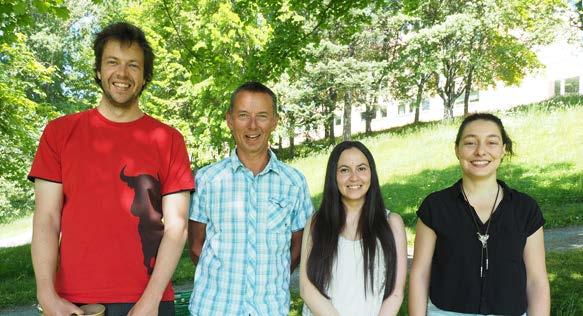
Major sCientifiC ContriButions
During 2020 we continued to contribute to the understanding of how environmental change influences aquatic ectotherms. When a change in the environment occurs, organisms can maintain an optimal phenotypic state via plastic, reversible changes to their phenotypes. While such phenotypic plasticity has been studied for more than half a century, global environmental change has stimulated renewed interest in quantifying variation in the rate and capacity with which this process occurs, particularly among ectothermic organisms. Yet, despite the likely ecological importance of acclimation capacity and rate, how these traits change throughout life among members of the same species is largely unstudied. Burton et al. (2020) investigated these relationships by measuring the acute heat tolerance of Daphnia magna of different size/age and acclimation status. The heat tolerance of individuals completely acclimated to relatively warm (28°C) or cool (17°C) temperatures diverged during development, indicating that older, larger individuals had a greater capacity to increase heat tolerance. However, when cool acclimated individuals were briefly exposed to the warm temperature (i.e. were ‘heat-hardened’), it was younger, smaller animals with less capacity to acclimate that were able to do so more rapidly because they obtained or came closer to obtaining complete acclimation of heat tolerance. Our results illustrate that within a species, individuals can differ substantially in how rapidly and by how much they can respond to environmental change. These results were followed up by Burton and Einum (2020), where we used the thermal death time curve framework to investigate the relationship between temperature tolerance and size/age by measuring the change in heat tolerance of Daphnia magna across a range of temperature intensities (and hence exposures of varying duration) among individuals that differed up to 3-fold in size and thus varied in age also. Across the gradient of exposure temperatures, younger, smaller individuals were more tolerant than older, larger individuals. This suggests that the young and the small may be better equipped to withstand temperature challenges that are both intense/brief and more moderate/prolonged. Our study generalizes results obtained from more acute tolerance assays, providing physiological evidence consistent with the observed reductions in ectotherm body size as a response to warming in aquatic systems. A second fundamental environmental factor that varies greatly in time and space is food abundance. Expression of phenotypic plasticity of life-history traits to such variation is crucial for individual fitness. Yet little is known about the neural signalling mechanisms underlying these reaction norms. Previous studies suggest a role for the dopamine system in regulating behavioural and morphological responses to food across a wide range of taxa. Issa et al. (2020) tested whether this neural signalling system also regulates life-history reaction norms by exposing Daphnia magna to both dopamine and the dopamine reuptake inhibitor bupropion, an antidepressant that enters aquatic environments via various pathways. We recorded a range of life-history traits across two food levels. Both treatments induced changes to the life-history reaction norm slopes. These were due to the effects of the treatments being more pronounced at restricted food ration, where controls had lower somatic growth rates, higher age and larger size at maturation. This translated into a higher population growth rate (r) of dopamine and bupropion treatments when food was restricted. Our findings show that the dopamine system is an important regulatory mechanism underlying life-history trait responses to food abundance and that bupropion can strongly influence life history.
Tim Burton, Sigurd Einum, Safa Chaabani, Semona Issa
RECOMMENDED READING:
Burton, T., Lakka, H.-K., Einum S. (2020) Acclimation capacity and rate change through life in the zooplankton Daphnia. Proceedings of the Royal Society B. 287: 20200189. doi.org/10.1098/rspb.2020.0189 Burton, T., Einum, S. (2020) The old and the large may suffer disproportionately during episodes of high temperature: evidence from a keystone zooplankton species. Conservation Physiology, 8: coaa038. doi.org/10.1093/conphys/coaa038 Issa, S., Gamelon, M., Maciej, T.C., Vike-Jonas, K., Asimakopoulos, A.G., Jaspers, V.L.B., Einum, S. (2020) Dopamine mediates lifehistory responses to food abundance in Daphnia. Proceedings of the Royal Society B. 287: 20201069. doi.org/10.1098/rspb.2020.1069
r researCh esearch group group: : d demographiC emographic responses responses To to a a Changing changing environmenT environment
Current group members: Current group members: PI: Researcher Ivar HerfindalPI: Researcher Ivar Herfindal Researcher Brett Sandercock (NINA) Research scientist Erling Johan Solberg (NINA) Researcher Erlend Birkeland Nilsen (NINA) Research scientist Erlend Birkeland Nilsen (NINA) Researcher Erling Johan Solberg (NINA) Research scientist Brett Sandercock (NINA) Researcher Hanno Sandvik (NINA) Researcher Hanno Sandvik (NINA) Postdoc Svenja Kroeger (NIBIO) Postdoc Svenja Kroeger (NIBIO) PhD candidate/Researcher Lars Rød-Eriksen (NINA) PhD candidate Endre Grüner Ofstad PhD candidate Lars Rød-Eriksen (NINA) Aim: To understand causes and consequences of spatial and temporal variation in demography Aim: To understand causes and consequences of demographic variation in time and space.
Our research group focuses on how individuals and Our research group focuses on how individuals and populations respond to environmental variation and human populations respond to environmental variation and human activities. In 2020, much of the research focussed on factors, such as harvesting. In 2019, much of the research was consequences of environmental variation and human activities done within the Vega moose project, which is a collaborative on spatial population dynamics and species interactions. project between NINA and NTNU/CBD. The strong involvement of researchers from NINA makes the research highly relevant for management and conservation.
Environmental variation is often correlated in space, and this Demography in harvested populations affects the spatial correlation in the dynamics of different populations, also known as spatial population synchrony. Harvesting is a major factor affecting dynamics and demography Herfindal et al. 2020 explored how the environment of animal populations. However, in a recent review Gamelon et synchronised populations by using data on juvenile body mass al. (2019) shows that we still have surprisingly little knowledge in moose and semi-domestic reindeer. As expected, weather about how harvesting in interaction with environmental variation conditions that had the strongest impact on juvenile body affects the population dynamics. In fact, most research on mass, and in a similar manner among all populations, had the the topic is theoretical, and more empirical work is therefore strongest synchronising effect. However, even if precipitation urgently needed to understand how harvesting can amplify or had a strong effect on body mass in both species, it did reduce impacts of environmental variation and climate change not synchronise body mass. This was due to a high spatial on population dynamics. heterogeneity in precipitation. Temperature, on the other hand, was correlated over great distances. The impact of harvesting on demographic and evolutionary processes depends on the management strategy, but previous The level of interspecific interactions varies spatially and can also studies have focussed mainly on age and sex specific mortality explain why populations are not synchronous. Previous models and deliberate harvest selection on specific phenotypes. The of interspecific competition assumed similar effects across Vega moose project represents a unique opportunity to assess populations, and that all individuals are influenced similarly. demographic contributions to evolutionary processes, for Gamelon et al. (2020) explored to what extent this holds true instance by quantifying the effective population size, Ne, which in a study of two chamois populations in Switzerland, both of influences genetic drift and rates of evolutionary response. A them co-existing with red deer. Vital rates of chamois were new study by Lee et al. (in press) showed that Ne was most not influenced by red deer abundance in the population with sensitive to the demographic variance of older males (Figure low spatial overlap between the two species. In contrast, in the 1), mainly caused by the high among-individual variation in population where chamois had a high spatial overlap with red deer vital rates were negatively affected by red deer abundance, Ivar Herfindal, Erling Johan Solberg, Erlend Birkeland Nilsen, Brett Sandercock, Hanno Sandvik, Svenja Kroeger, Endre Grüner Ofstad and Lars Rød-Eriksen. Ivar Herfindal, Erling Johan Solberg, Erlend Birkeland Nilsen, Brett Sandercock, Hanno Sandvik, Svenja Kroeger, Endre Grüner Ofstad and Lars Rød-Eriksen.
but only among young and senescent individuals. Such habitatdependent consequences on demography were also found in a study of marmots by Kroeger et al. 2020. Here, daughters born to older mothers had greater annual and greater lifetime reproductive success than daughters born to younger mothers. However, at lower elevation, daughters born to older mothers also had greater age-specific decreases in annual reproductive success, whereas in the higher elevation environment, daughters born to older mothers tended to die before reaching ages at which senescent decreases could be observed.
The level of interspecific interactions is often affected by human activities, and often through indirect mechanisms. One important consequence of our activity is invasion of species into novel habitats, and this was the topic of Lars Rød Eriksen’s PhD thesis which he successfully defended in spring 2020. In one of his papers (Rød-Eriksen et al. 2020), he shows how the large amount of human waste along alpine highways attracts scavenging species such as corvids and red fox. This increased Figure 1. Older males contributed most to the demographic variance. Bars show cumulative sum of the sex-age class specific demographic variances weighted by the proportion of individuals in each sex-age class at stable both the nest predation along the road and the competition between the boreal species red fox and the alpine species arctic fox. Because the red fox is the stronger competitor arctic fox stage structure. Numbers on bars indicate age classes (years). avoided areas nearby highways where abundance of human waste was high (Figure 1). This shows how human infrastructure may have unexpected consequences on local fauna.
In anthropogenically altered ecosystems where human activities often affect the individual vital rates, a detailed understanding of seasonal and demographic variation in these rates is often needed for sustainable management. Israelsen et al. 2020 used detailed data from an ongoing field study of willow ptarmigan to decompose the annual mortality risks for different age- and sex classes. As expected, harvest represented a main source of mortality in the fall, whereas other natural causes dominated in other seasons (Figure 2). The highest risk of mortality was in the fall and in the spring during the breeding season. These analyses provide unique insight into demographic and seasonal patterns in willow ptarmigan mortality risks in a harvested population and revealed a complex interplay across seasons, risk factors, and demographic classes. Such insight is valuable when designing sustainable management plans in a world undergoing massive environmental perturbations.
Another important human impact on ecosystems is introduction of alien species, and their ecological impact is a function of the area colonised. Impact assessments of alien species are thus incomplete unless they take the spatial component of invasion processes into account. Sandvik (2020) and Sandvik et al. (2020) developed a measure, termed expansion speed, that quantifies the speed with which a species increases its spatial presence in an assessment area. The method utilises time series of spatio-temporal observation data, and takes into account that the detection probability of new occurrences is often far from 100% and may vary through time. The method has been applied during the impact assessments of 1519 alien species in Norway, organised by the Norwegian Biodiversity Information Centre. RECOMMENDED READING:
Gamelon, M., Filli, F., Sæther, B.-E., & Herfindal, I. (2020). Multievent capture-recapture analysis in two Alpine chamois populations reveals population-specific responses to interspecific competition. Journal of Animal Ecology, 89, 22792289. Herfindal, I., Tveraa, T., Stien, A., Solberg, E.J., & Grøtan, V. (2020). When does weather synchronise life history traits? Spatiotemporal patterns in juvenile body mass of two ungulates. Journal of Animal Ecology, 89, 1419-1432. Israelsen, M.F., Eriksen, L.F., Moa, P.F., Hagen, B.R., and Nilsen, E.B. 2020. Survival and cause-specific mortality of harvested willow ptarmigan (Lagopus lagopus) in central Norway. Ecology and Evolution, 10, 11144-11154. Kroeger, S.B., Blumstein, D.T., Armitage, K.B., Reid, J.M. and Martin, J.G.A. 2020. Older mothers produce more successful daughters. Proceedings of the National Academy of Sciences of the United States of America 117, 4809-4814. Rød-Eriksen, L., Skrutvold, J., Herfindal, I., Jensen, H., & Eide, N. E. (2020). Highways associated with expansion of boreal scavengers into the alpine tundra of Fennoscandia. Journal of Applied Ecology 57, 1861-1870. Sandvik, H. (2020) Expansion speed as a generic measure of spread for alien species. Acta Biotheoretica 68, 227–252. Sandvik, H., O. Hilmo, S. Henriksen et al. (2020) Alien species in Norway: results from quantitative ecological impact assessments. Ecological Solutions and Evidence, 1, e12006.

Figure 1. Predicted number of tracks of red (red line) and arctic (blue line) fox per km in relation to the number of edible items of anthropogenic origin per km found along road verges. From Rød-Eriksen et al. 2020. Figure 2. Willow ptarmigan seasonal mortality risks, decomposed to harvest mortality vs other mortality
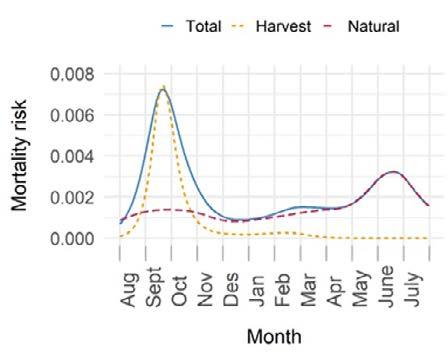
researCh group: stoChastiC theories
Current group members: PI: Professor Jarle Tufto Professor Steinar Engen PhD candidate Yihan Cao
Aim: To develop theories for the dynamics of populations, phenotypes and communities in fluctuating environments.
The group aims to develop stochastic theoretical models and statistical methods for estimating parameters of such models to understand ecological and evolutionary processes involving different forms of environmental and demographic stochasticity. Steinar Engen, Yihan Cao Right: Jarle Tufto

major sCienTifiC ConTribuTions
Many species show synchronous fluctuations in population size over large geographical areas, which are likely to increase their regional extinction risk. In Jarillo et. al. (2020) the degree of spatial synchrony in population dynamics affected by trophic interactions using a two-species predator-prey model with spatially correlated environmental noise is examined. It is shown that the predator has a larger spatial scale of population synchrony than the prey if the population fluctuations of both species are mainly determined by the direct effect of stochastic environmental variation in the prey. This result implies that in ecosystems regulated from the bottom up, the spatial scale of synchrony of the predator population increases beyond the scale of the spatial autocorrelation in the environmental noise and in the prey fluctuations. Harvesting the prey increases the spatial scale of population synchrony of the predator, while harvesting the predator reduces the spatial scale of the population fluctuations of its prey. Hence, the development of sustainable harvesting strategies should also consider the impact on unharvested species at other trophic levels as well as human perturbations of ecosystems, whether the result of exploitation or an effect on dispersal processes, as they can affect food web structures and trophic interactions over large geographical areas.
Many ecological and evolutionary processes strongly depend on the way natural selection varies over time. However, a gap remains when trying to connect theoretical predictions to empirical work on this question: Most theory assumes that adaptation involves tracking a moving optimum phenotype through time, but this is seldom estimated empirically. Several CBD members including Tufto, Gamelon and Kvalnes participated in an international team, assembling a large database of wild bird and mammal populations, to estimate patterns of fluctuations in the optimum breeding date and its influence on the variability of natural selection (Villemereuil et. al. 2020). They find that fluctuations in phenotypic optima are prevalent. However, their influence on temporal variance in natural selection is partly buffered by tracking of the optimum phenotype through individual phenotypic plasticity (see also the RG: Synthesis).
RECOMMENDED READING:
J. Jarillo, B.-E. Sæther, S. Engen, F. J. Cao-Carcía (2020) Spatial Scales of Population Synchrony in Predator-Prey Systems. American Naturalist 195: 216-230 P. de Villemereuil, A. Charmantier, D. Arlt, P. Bize, P. Brekke, L. Brouwer, A. Cockburn, S. D. Côté, F S. Dobson, S. R. Evans, M. Festa-Bianchet, M. Gamelon, S. Hamel, J. Hegelbach, K. Jerstad, B. Kempenaers, L. E. B. Kruuk, J. Kumpula, T. Kvalnes, A. G McAdam, S. E. McFarlane, M. B. Morrissey, T. Pärt, J. M. Pemberton, A. Qvarnström, O. W. Røstad, J. Schroeder, J. C. Senar, B. C. Sheldon, M. van de Pol, M. E. Visser, N. T. Wheelwright, J. Tufto, L.-M. l Chevin (2020) Fluctuating optimum and temporally variable selection on breeding date in birds and mammals. Proceedings of the National Academy of Sciences 117: 31969-31978.
Photo: Per-Harald Olsen
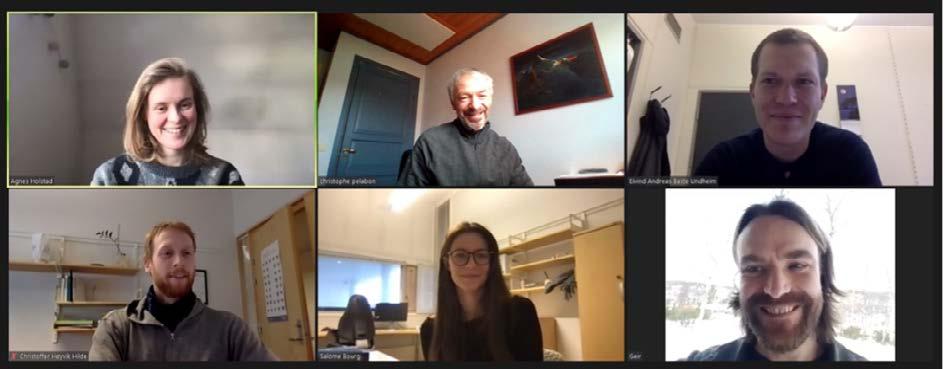
Agnes Holstad, Christophe Pélabon, Eivind Undheim, Christoffer H Hilde, Salomé Bourg, Geir H Bolstad
Current group members: PI: Professor Christophe Pélabon Researcher Geir H. Bolstad (NINA) Postdoc Eivind Undheim Postdoc Salomé Bourg PhD candidate Agnes Holstad PhD candidate Christoffer H Hilde
Aim: Understand the evolutionary dynamics of complex traits.
The group is testing predictive models for the evolutionary dynamics of multivariate quantitative traits, focusing particularly on the evolutionary constraints generated by the genetic architecture of the traits. Using both experimental and comparative approaches, the group aims at operationalizing measures of the evolutionary potential or evolvability. In collaboration with R. Morgan and F. Jutfelt from the physiology group at the institute of Biology (NTNU), the group has published a paper on the subject in 2020 in PNAS. Together with Prof. T. Hansen from the university of Oslo, C. Pélabon has co-organized a one-year workshop on Evolvability at the Centre of Advance Studies (CAS) in Oslo that ended in June 2020.
major sCienTifiC ConTribuTions
The evolutionary potential of thermal tolerance
The rapid change in the global temperature generates great concern about the ability of organisms to adapt to warmer environments. During heat waves, upper thermal tolerance is often critical for survival, but it remains unknown whether and how rapidly tolerance can evolve. The paper published in the Proceedings of the National Academy of Science with Rachael Morgan as lead author reports the results of an artificial selection experiment on upper thermal tolerance in a tropical fish. After six episodes of selection, upper thermal tolerance evolved but at a slower rate toward higher than lower temperatures. Furthermore, acclimation capacity decreased in the lines selected for higher thermal tolerance. These results suggest the existence of a hard limit in upper thermal tolerance that generates directional epistasis, that is, changes in interaction among loci when allele substitutions at different loci systematically reinforce (positive epistasis) or weaken (negative epistasis) allelic effects. In the case of upper thermal tolerance, allele substitutions that increase the mean systematically decrease the effect of other allele substitutions (negative epistasis). Such directional epistasis provokes changes in additive variance with changes in the mean upper thermal tolerance at short (ecological) time scale (see figure 1).
The project on Evolvability at the Centre for Advanced Study (CAS) in Oslo ended in June 2020. This project aimed at unifying the theory of evolvability and promoting this concept as one of the major concepts in the evolutionary theory. Two main axes of activity have been followed during this year. The first one in theory of Science (leader Laura Nuño de la Rosa), consisted of interviewing scientists that have been central in developing the concept of evolvability during the last 30 years. The idea of this project is to present both a conceptual and historical view of evolvability as seen by the people that developed this concept. The group has completed 19 interviews of many of the key actors in the different disciplines, including some prominent figures such as Richard Dawkins, Massimo Pigliucci, and Günter Wagner. The second part of the project was to synthesise the research in evolvability in order to identify commonality and differences in the use of the concept in different fields of evolutionary biology. This part of the project will be the main subject of a book on Evolvability to be published by MIT press in the Vienna Series in Theoretical Biology edited by G. Muller during the fall 2021.
RECOMMENDED READING:
Morgan, R., M.H. Finnøen, H. Jensen, C. Pélabon, & F. Jutfelt. 2020 Low potential for evolutionary rescue from climate change in a tropical fish. PNAS 117: 33365–33372. https://doi.org/10.1073/pnas.2011419117 Hilde, C. H., Gamelon, M., Sæther, B. E., Gaillard, J. M., Yoccoz, N. G., & Pélabon, C. (2020). The demographic buffering hypothesis: evidence and challenges. Trends in Ecology &
Evolution. https://doi.org/10.1016/j.tree.2020.02.004 Pélabon, C., Hilde, C.H., Einum, S., & Gamelon, M. (2020). On the use of the coefficient of variation to quantify and compare trait variation. Evolution Letters. https://doi.org/10.1002/evl3.171

Figure 1: Non-linear GP map with a ceiling (A), that result from physiological constraints such as protein denaturation with temperature. The concave shape generates negative directional epistasis as the trait is increasing. Therefore, the same distribution of molecular genetic effects at different positions on the x-axis will generate different trait distributions and hence different evolvabilities at different positions on the y-axis. The consequence is an asymmetric response to selection (B), which is decelerating in the up lines and accelerating in the down lines (redrawn from Morgan et al. 2020).
Current group members: PI: Professor Henrik Jensen Professor Ingelin Steinsland Professor Stig W. Omholt Associate Professor Arild Husby Associate Professor Michael D. Martin Associate Professor Stefanie Muff Associate Professor Thor Harald Ringsby Researcher Ingerid J. Hagen (NINA) Researcher Peter S. Ranke Postdoc Laurène Lecaudey PhD candidate Dilan Saatoglu PhD candidate Fabian Kellner PhD candidate Gabriel David (Uppsala University) PhD candidate Hamish A. Burnett PhD candidate Isabelle Russell PhD candidate Janne C. Hetle Aspheim PhD candidate John McAuley (University of Edinburgh) PhD candidate Maria L. Selle PhD candidate Michael Le Pepke PhD candidate Sarah Lundregan PhD candidate Sindre L. Sommerli PhD candidate Vanessa Bieker PhD candidate Ådne M. Nafstad Engineer Henrik Pärn Engineer Oskar Speilberg
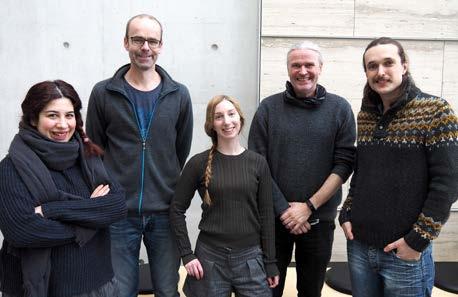
Aim: To improve our understanding of interactions between ecological and genetic dynamics.
Dilan Saatoglu, Henrik Jensen, Sarah Lundregan, Thor Harald Ringsby, Michael P. Pedersen
Photo: Per-Harald Olsen
Our research group produces knowledge targeting key questions at the interface between RA1 and RA2. In particular, our goals are to examine how spatiotemporal variation in population dynamics (including the effects of density dependence, environmental stochasticity and dispersal) interact with phenotypic variation and evolutionary dynamics, and the role of genetic variation in these interactions. Furthermore, our group seeks to understand the genetic basis of the evolution of diversity within and across species, which may be very rapid on geological timescales. To achieve our goals we combine state-of-the-art genomic tools with development and application of novel statistical methods. Using such interdisciplinary approaches, we analyze individual-based data on fitness-related phenotypic traits, life history traits, and fitness components, as well as genome-level genetic variation across populations and species. Our main study systems are several intensively studied natural vertebrate metapopulations, including house sparrows, water voles, arctic foxes and Atlantic salmon, as well as various groups of plants such as Daisy trees and ragweed. We also provide molecular genetic resources and assistance needed by other research groups in all three RAs at CBD. Furthermore, the empirical individual-based data on phenotypic traits, fitness, and genetic variation we produce are, along with results from our studies not only needed to parameterize and test models developed by other RGs at CBD, but also particularly attractive for scientists who wish to use our unique data in international and national collaborative projects that test hypotheses and answer questions in various fields in biology.
Major sCientifiC ContriButions
Inbreeding may increase the extinction risk of small populations by causing inbreeding depression, a reduction in individual fitness. Natural populations often experience different environmental conditions and differ in demographic history and genetic composition, characteristics that can affect the severity of inbreeding depression. Studying these mechanisms in wild vertebrates has been prevented by the difficulty of collecting long-term data on multiple populations. Furthermore, studies using modern genomic tools to investigate inbreeding depression in nature have been limited to single populations, and little is known about the dynamics of inbreeding depression in fragmented populations over time. We utilized extensive long-term data on more than 3,100 individuals from eight islands in an insular house sparrow metapopulation to examine the generality of inbreeding effects. Using genomic estimates of realized inbreeding, we discovered that inbred individuals had lower survival probabilities and produced fewer recruiting offspring than non-inbred individuals. Inbreeding depression, measured as the decline in fitness-related traits per unit inbreeding, did however not vary appreciably among populations or with time. As a consequence, populations with higher average levels of inbreeding (due to their demographic history) paid a higher total fitness cost, evidenced by a larger variance in fitness explained by inbreeding within these
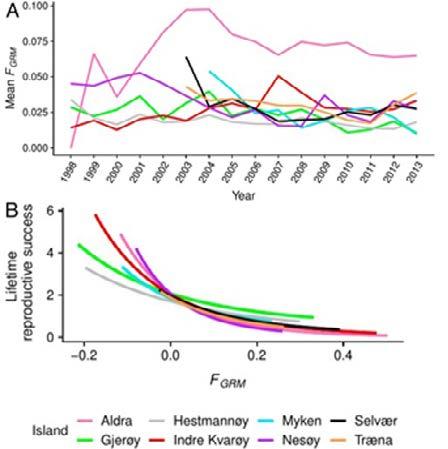
Figure 1. Mean inbreeding coefficient (FGRM) of adult individuals on eight islands in a metapopulation of house sparrows at the coast of Helgeland, Norway (A). Island-specific effects of inbreeding on lifetime reproductive success on the same eight islands (B).
populations. Our results highlight the importance of considering inbreeding in conservation and management of populations with a wide range of characteristics.
The genetic architecture and adaptive potential of response to parasite challenge
Host–parasite relationships are likely to change in response to climate change and increased anthropogenic stressors. Understanding the genetic architecture of parasite resistance will aid prediction of species’ responses to intensified parasite challenge. The gapeworm “Syngamus trachea” is prevalent in natural bird populations and causes symptomatic infections ranging from mild to severe. The parasite may affect ecological processes by curtailing bird populations and is important due to its propensity to spread to commercially farmed birds. Because our large-scale data set on an insular house sparrow metapopulation in northern Norway includes information on gapeworm prevalence and infection intensity, we could assess the genetics of parasite resistance in a natural system. To determine whether parasite resistance has a heritable genetic component, we performed variance component analyses using suitable statistical models, so-called animal models. Resistance to gapeworm had substantial additive genetic and dominance variance, and genome-wide association studies to identify single nucleotide polymorphisms associated with gapeworm resistance yielded multiple loci linked to immune function. Together with genome partitioning results, this indicates that resistance to gapeworm is under polygenic control in the house sparrow, and probably in other bird species. Hence, our results provide the foundation needed to study any eco-evolutionary processes related to gapeworm infection, and show that it is necessary to use methods suitable for polygenic and nonadditive genetic effects on the phenotype.
When performing genetic evaluation, breeders and geneticists use statistical models to separate genetic and environmental effects on phenotype. A common way to separate these effects is to model a descriptor of an environment, a contemporary group or herd, and account for genetic relationship between animals across environments. However, separating the genetic and environmental effects in smallholder systems is challenging due to small herd sizes and weak genetic connectedness across herds. We performed simulations and real dairy cattle data analysis to evaluate the potential of spatial modelling to improve genetic evaluation in dairy cattle smallholder systems, and compared models using pedigree or genomic data. Our results showed that in smallholder systems spatial modelling increases the accuracy of genetic evaluation for phenotyped and non-phenotyped animals, and that spatial modelling

Figure 2. Results from genome-wide association studies on S. trachea resistance (faecal egg count) in an insular house sparrow metapopulation at the coast of Helgeland, Norway, using nonadditive association tests. The plot shows the negative logarithm of the p-value for markers against the chromosomal position in the house sparrow genome, and the horizontal dashed line indicate an FWER of 0.05. 18 SNPs were significant at this threshold.
Figure 3. A conceptual illustration of the simulation used to evaluate the potential of spatial modelling to improve genetic evaluation (Selle et al. 2020). The simulated data resembled the smallholder systems commonly observed in East Africa with small herds clustered in villages and a varying level of genetic connectedness. Each point denotes an animal, their location in a country and colour of the point denotes value of phenotype (top left panel) and underlying genetic (top right panel), herd (bottom left panel) and spatial (bottom right panel) effects. Note the most bottom-right village (cluster) with high genetic merit animals, but intermediate phenotypes due to negative spatial effects.
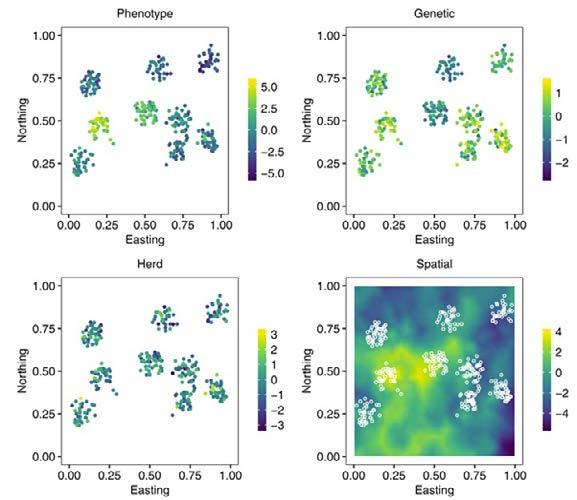
was beneficial when using either pedigree or genomic data. This improvement was driven by establishing environmental connectedness between herds, which enhances separation of genetic and environmental effects. This may be important not only in animal breeding, and we suggest that spatial modelling could also have a major impact in studies of human and wild populations. RECOMMENDED READING:
Lundregan, S.L., Niskanen, A.K., Muff, S., Holand, H., Kvalnes, T., Ringsby, T.-H., Husby, A., and Jensen, H. 2020. Resistance to gapeworm parasite has both additive and dominant genetic components in house sparrows, with evolutionary consequences for ability to respond to parasite challenge. Molecular Ecology, 29, 3812–3829. Niskanen, A.K., Billing, A.M., Holand, H., Hagen, I.J., Araya-Ajoy, Y.G., Husby, A., Rønning, B., Myhre, A.M., Ranke, P.S., Kvalnes, T., Pärn, H., Ringsby, T.H., Lien, S., Sæther, B.-E., Muff, S., and Jensen, H. 2020. Consistent scaling of inbreeding depression in space and time in a house sparrow metapopulation. Proceedings of the National Academy of Sciences of the United States of America, 117, 14584-14592. Selle, M.L., Steinsland, I., Powell, O., Hickey, J.M., and Gorjanc, G. 2020. Spatial modelling improves genetic evaluation in smallholder breeding programs. Genetics Selection Evolution, 52, 69.
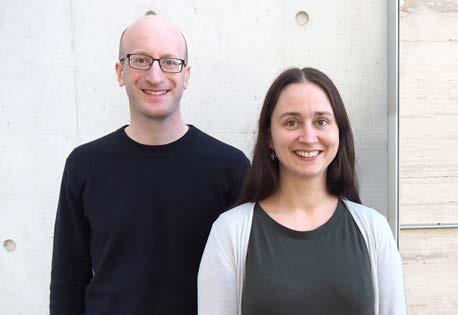
researCh group: modelling behaviour in sToChasTiC environmenTs
Current group members: PI: Associate professor Irja Ida Ratikainen Guest researcher Martin I. Lind
Aim: To increase understanding of behavioural and life history strategies in stochastic environments
Major sCientifiC ContriButions
Graduated PhD candidate Thomas Haaland has led the modelling of how specialists and generalists do in environments that fluctuate in different ways. In this work we have shown that environmental variability affects optimal amounts of phenotypic variation within and among individuals to maximize genotype fitness, and we disentangle the effects of individual-level optimization and genotype-level bet-hedging by comparing long-term arithmetic versus geometric mean fitness. The results depend on the type of trait. Some traits, such as foragingrelated traits, have additive fitness effects within lifetimes, and for these traits it is equally good for a genotype to be a generalist as a diversified, bet-hedging, specialist. For traits that have multiplicative fitness effects within lifetimes, such as traits affecting sequential survival probabilities, generalist individuals are always favored. In this case, the long-term benefits of withinindividual phenotypic variation are so beneficial to a genotype that it will cause individuals to be more generalist than required to simply maximize their own expected fitness.
In contrast to previous results in the bet-hedging literature, this generalist strategy is always favored over diversifying bet-hedging where individuals will produce different specialist offspring. Our results link the evolution of behavioral and ecological specialization with earlier models of bet-hedging and can aid our understanding of a range of natural phenomena from habitat choice to host specificity in parasites. Martin Lind, Irja Ida Ratikainen
Photo: Per-Harald Olsen
Parents can help their offspring by adjusting offspring’s phenotype to match their environment. Such anticipatory parental effects would be beneficial, but only if parents can accurately predict the environment in which their offspring will develop and live. The plausibility of such anticipatory parental effects is hotly debated. The theory is clear that the predictability of the environment should play a defining role. We used an “experimental evolution” approach in a fast reproducing nematode worm Caenorhabditis remanei to tackle this question and follow the evolution of parental effects in different environments in real time. We found that populations evolving in a novel but predictable environment indeed had anticipatory parental effects that increased fitness of their offspring in that environment. In contrast, when evolving in an unpredictable environment where such parental effects would be disadvantageous, the parental effect was rapidly lost in evolution. Our novel experimental environments were constructed by exposing worms to increased temperature. Anticipatory parental effects play an important role in adaptation to novel environments and will affect the viability of populations under climate heating.
RECOMMENDED READING:
Haaland, T.R., Wright, J. and Ratikainen, I.I. 2020. Generalists versus specialists in fluctuating environments: a bet-hedging perspective. Oikos 129 (6) 879-890. doi: 10.1111/oik.07109 Lind MI, Zwoinska MK, Andersson J, Carlsson H, Krieg T, Larva T and AA Maklakov (2020). Environmental variation mediates the evolution of anticipatory parental effects. Evolution Letters 4: 371-381
researCh group: adapTaTions To (un)prediCTable environmenTal Change
Current group members: PI: Professor Jonathan Wright Postdoc Yimen Araya-Ajoy PhD candidate Mette Helene Finnøen PhD candidate Myranda O’Shea
Aim: To explore adaptive evolution in fluctuating environments.
This research group contributes to the research program of CBD primarily in Research Area 2. A variety of approaches is applied: from the development of mathematical models and wider conceptual frameworks to detailed life history and behavioural studies on vertebrates in the field and laboratory. Environmental variation is becoming more frequent and unpredictable as a consequence of anthropogenic change, yet we currently lack the tools to evaluate the extent to which organisms can adapt to this phenomenon. Adaptations to predictable shortterm environmental variation should favour reversible or irreversible (developmental) plasticity, whilst unpredictable long-term environmental variation will favour bet-hedging and adaptive tracking. A fundamental challenge here is in defining such adaptive phenomena for phenotypes that vary hierarchically among species, populations, genotypes and individuals, and also within individuals for repeatedly expressed labile phenotypic traits (behaviour, physiology and morphology). To address this challenge, we combine approaches from behavioural ecology and quantitative genetics, using statistical models and the concept of the reaction norm to explore phenotypic variation among Jonathan Wright, Mette Helene Finnøen, Yimen Araya-Ajoy Right: Myranda O’Shea

individuals alongside within-individual plasticity in labile and social phenotypes. Working at the interface between theoretical and empirical research, we are involved in a wide range of activities from the development of mathematical models and wider conceptual frameworks to detailed life history and behavioural studies on vertebrates in the field and laboratory.
Major sCientifiC ContriButions
1 Density-dependent selection at different life stages creates a second ‘pace-of-life’ axis
There has been much recent research interest in the existence of a major axis of life history variation along a fast-slow pace-oflife continuum within almost all major taxonomic groups. Ecoevolutionary models of density-dependent selection provide a general explanation for such observations of interspecific variation in the pace-of-life. One issue, however, is that some large-bodied long-lived ‘slow’ species (e.g. trees and large fish) often show an explosive ‘fast’ type of reproduction with many small offspring, and species with ‘fast’ adult life stages can have comparatively ‘slow’ offspring life stages (e.g. mayflies). We attempt to explain such life history evolution using the same eco-evolutionary modelling approach but with two life stages, separating adult reproductive strategies from offspring survival strategies (Fig.1). When the population dynamics in the two life stages are closely linked and affect each other, density-dependent selection occurs in parallel on both reproduction and survival, producing the usual one-dimensional fast-slow continuum (Fig.2A). However, strong density dependence at either the adult reproduction or offspring survival life stage creates quasi-independent population dynamics, allowing fast-type reproduction alongside slow-type survival (e.g. trees and large fish), or the perhaps rarer slow-type reproduction alongside fast-type survival (e.g. mayflies - short-lived adults producing few long-lived offspring) – Fig.2B. Therefore, most types of species life histories in nature can potentially be explained via the eco-evolutionary consequences of density-dependent selection given the possible separation of demographic effects at different life stages.

Figure 1. Model simulation results representing four extreme types of life history: A ‘mayflies’ with fast-selected adult reproduction and slow-selected offspring survival; B ‘houseflies’ with fast-selected reproduction and survival; C ‘blue whales’ with slow-selected reproduction and survival; and D ‘oak trees’ with slow-selected reproduction and fast-selected survival. Changes over time (generations) are shown as lines for populations sizes of adults (N, black) and offspring (n, green), and for values of the reproduction (z1, red) and survival (z2, blue) traits, with deterministic values for simulations with no environmental stochasticity (black dashed horizontal lines) for comparison.
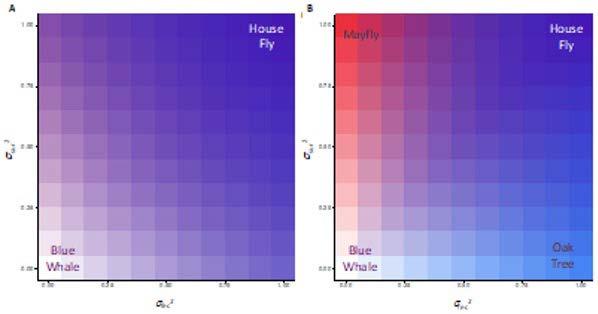
Figure 2. Model simulation results for adult reproduction trait z1 (red) and offspring survival trait z2 (blue). White contours indicate 0.3 intervals in mean trait values (z1 solid, z2 dashed). Results are shown for increasing levels of environmental stochasticity in offspring survival populations (σ2 sur) and in adult reproductive populations (σ2 fec). In A limited density dependence produces the traditional one-dimensional fast-slow life history continuum. However, in B strong density dependence allows quasi-independent population dynamics in the two life stages, orthogonal changes in the contours, and all four colours and alternative types of life history (‘housefly’, ‘blue whale’, ‘oak tree’ and ‘mayfly’ – model values as in Fig.1).
Figure 3. Path diagrams of social evolution. Symbols in solid line boxes are measured variables, symbols in dashed line boxes represent unmeasured (statistically inferred) variables. Numbers in circles are paths (ρ) representing the relationships between variables. (A) Indirect routes to fitness. ρ1 reflects the genetic underpinning of the focal individual’s trait, represented as the effect of breeding values a on trait z with e representing unmeasured environmental effects. ρ2 is the relationship between the trait of the focal individual z and its relative fitness ω (βn). ρ3 represents the genetic relatedness (r) or covariance between interacting individuals. ρ4 reflects the genetic underpinning of the trait z’ of social partner(s), represented as the effect of genes a’ on trait z’ with e’ again representing unmeasured environmental effects. ρ5 is the relationship between the trait of the social partner z’ and the focal individual’s fitness ω, which can be interpreted as the social selection gradient (βS). ρ6 is the social impact (Ψzz’) of the phenotype of individual z on the phenotype z’ of the social partner(s).
(B) Social responsiveness and the evolution of the social
environment. ρ7 represents the social responsiveness (Ψz’z) of the phenotype of the focal individual to the phenotype of its social partner. ρ8 represents the direct selective pressesures (β’N) on the social partner(s) phenotype and ω’ the fitness of the social partner(s). (C) Interacting fitness effects. ρ9 and ρ10 represent the influences of the focal and social partner(s) traits on the aggregate character zz’. ρ11 represents interactive fitness effects (β1) mediated by the aggregate character (zz’).

In the context of social evolution, the ecological drivers of selection are the phenotypes of other individuals. The social environment can thus evolve, potentially changing the adaptive value for different social strategies. Different branches of evolutionary biology have traditionally focused on different aspects of these feedbacks. We synthesize behavioural ecology theory concerning evolutionarily stable strategies when fitness is frequency dependent with quantitative genetic models providing statistical descriptions of evolutionary responses to social selection. Using path analyses, we review how social interactions influence the strength of selection and how social responsiveness, social impact, and non-random social assortment affect responses to social selection. We then detail how the frequency-dependent nature of social interactions fits into this framework and how it imposes selection on traits mediating social responsiveness, social impact, and social assortment, further affecting evolutionary dynamics. Throughout, we discuss the parameters in quantitative genetics models of social evolution from a behavioural ecology perspective and identify their statistical counterparts in empirical studies. This integration of behavioural ecology and quantitative genetic perspectives should lead to greater clarity in the generation of hypotheses and more focused empirical research regarding evolutionary pathways and feedbacks inherent in specific social interactions.
RECOMMENDED READING:
Wright, J., Solbu, E.B. & Engen, S. (2020) Contrasting patterns of density-dependent selection at different life stages can create more than one axis of life-history variation. Ecol. & Evol. 10, 3068-3078. Engen, S., Wright, J., Araya-Ajoy, Y. & Sæther, B.-E. (2020) Phenotypic evolution in stochastic environments: the contribution of frequency- and density-dependent selection.
Evolution 74, 1923–1941. Araya-Ajoy, Y.G., Westneat, D.F. & Wright, J. (2020) Pathways to social evolution and their eco-evolutionary feedbacks.
Evolution 74, 1894–1907
researCh group: linking populaTion, evoluTionary and ConservaTion eCology
Current group members: PI: Professor Jane Margaret Reid Posdoc Paul Acker PhD candidate Lisa Dickel PhD candidate Sarah Fenn PhD candidate Vicki Dale
Aim: To understand how population dynamics and evolutionary dynamics can affect each other, and to apply such understanding to help conserve wild animal populations.
Jane M. Reid, Paul Acker, Lisa Dickel
Major sCientifiC ContriButions
In pure science, our research group focused on understanding how different forms of movement, namely dispersal and reversible seasonal migration, can shape population and evolutionary dynamics.
First, we used long-term data from free-living song sparrows (Melospiza melodia) to examine how incoming immigrants into a focal population alter patterns of genetic variation and the progress of evolution (Figure 1). We showed that immigrants import genes that increase the degree of reproductive mate fidelity, and hence decrease the degree to which a female’s offspring are sired by multiple males. Immigration thereby alters the reproductive system, and alters the form of genetic constraints acting across interacting females and males (Reid & Arcese 2020). This also provided important evidence that immigrants can import genes that decrease local survival, and hence constrain the course of adaptive evolution (Reid et al. 2020). The PhD student, Lisa Dickel, is now extending this project to full quantify effects of immigrants on individual and population fitness.
Second, we used multi-year data from European shags (Phalacrocorax aristotelis) to quantify patterns of phenotypic variation in, and natural selection on, the expression of seasonal migration versus year-round residence. This project is run in close collaboration with Dr Francis Daunt and colleagues at the UK Centre for Ecology & Hydrology. We showed that there is considerable among-individual variation in expression of seasonal migration versus residence, with associations with reproductive success that also differed between two focal years (Reid et al. 2020). We also showed that, across nine years, episodes of strong selection against year-round residence occurred, and were closely associated with extreme climatic events manifested as severe winter storms (Figure 2, Acker et al. 2020). Together these results demonstrate substantial phenotypic variation in a key movement trait that directly shapes spatio-seasonal population dynamics and distributions, and demonstrates that such variation can be subject to strong and highly variable selection.
We also advanced projects on joint population and evolutionary dynamics involving mating systems and inbreeding (with PhD students Max Tschol and Anders Paulsen, and collaborator Dr Greta Bocedi at University of Aberdeen), and on ecological and life-history predictors of changing migration phenology (with PhD student Vicki Dale at University of Aberdeen).
In applied science, I led the science base for ongoing conservation management for a protected bird, the red-billed chough (Pyrrhocorax pyrrhocorax), in Scotland. PhD student
Figure 1. An immigrant song sparrow, whose genes could reduce local survival and alter the reproductive system.
Figure 2. Estimated annual survival probabilities of full-winter resident and full-winter migrant European shags. Two years of strong selection against residents are highlighted.
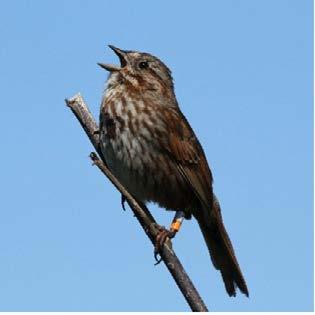
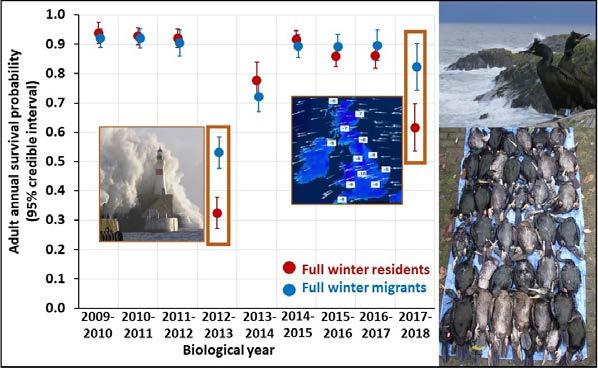
Sarah Fenn (University of Aberdeen) and our colleagues showed that a programme of supplementary feeding which had been designed to target sub-adults had unplanned collateral benefits by also increasing adult survival and hence population growth rate (Fenn et al. 2020, Journal of Applied Ecology). These results, alongside existing understanding of ecological and genetic constraints on population persistence, were incorporated into a major commissioned report for NatureScot, which is now informing plans for future conservation actions (Trask et al. 2020).
RECOMMENDED READING:
Acker, P, Daunt, F, Wanless, S, Burthe, SJ, Newell, M, Harris, MPH, Grist, H, Sturgeon, J, Gunn, C, Payo-Payo, A, Reid, JM (2020) Strong survival selection on seasonal migration versus residence induced by extreme climatic events. Journal of Animal Ecology online. https://doi.org/10.1111/13652656.13410 Fenn, SR, Bignal, EM, Trask, AE, McCracken, DI, Monaghan, P, Reid, JM (2020) Collateral benefits of targeted supplementary feeding on demography and growth rate of a threatened population. Journal of Applied Ecology 57, 2212-2221. https://doi.org/10.1111/1365-2664.13721 Reid, JM, Arcese, P (2020) Recent immigrants alter the quantitative genetic architecture of paternity in song sparrows. Evolution Letters 4, 124-136. https://doi. org/10.1002/evl3.162 Reid, JM, Arcese, P, Nietlisbach, P, Wolak, ME, Muff, S, Dickel, L, Keller, LF (2020) Immigration counter-acts local microevolution of a major fitness component: migration-selection balance in free-living song sparrows. Evolution Letters online. https://doi.org/10.1002/evl3.214 Reid, JM, Souter, M, Fenn, SR, Acker, P, Payo-Payo, A, Burthe, SJ, Wanless, S, Daunt, F (2020) Among-individual and withinindividual variation in seasonal migration covaries with subsequent reproductive success in a partially-migratory bird. Proceedings of the Royal Society B 287, 20200928. https:// doi.org/10.1098/rspb.2020.0928 Trask, AE, Bignal, E, Bignal, S, McCracken, DI, Fenn, SR, Monaghan, P, Reid, JM (2020) Conservation strategy for red-billed choughs in Scotland: Assessment of the impact of supplementary feeding and evaluation of future management strategies. Commissioned Research Report for NatureScot. https://www.nature.scot/sites/default/files/2020-07/ Publication%202020%20-%20SNH%20Research%20 Report%201152%20-%20Conservation%20strategy%20 for%20red-billed%20choughs%20in%20Scotland.pdf
researCh group: CoMMunity DynaMiCs
Current group members: PI: Associate professor Vidar Grøtan Professor Anders Gravbrøt Finstad Professor Bob O’Hara Professor Otso Ovaskainen Senior researcher Ola Diserud Researcher Knut Anders Hovstad (Norwegian Biodiversity Information Centre) Postdoc Christophe Coste Postdoc Emily Grace Simmonds PhD candidate Bert van der Veen (NIBIO) PhD candidate Caitlin Mandeville PhD candidate Ellen Claire Martin PhD candidate Kwaku Adjei PhD candidate Lisa Sandal PhD candidate Sam Perrin PhD candidate Tanja Petersen PhD candidate Wouter Koch (Norwegian Biodiversity Information Centre)
Aim: To examine how community dynamics in time and space of different taxa along ecological gradients are affected by environmental stochasticity.
Tanja Petersen, Lisa Sandal, Anders Gravbrøt Finstad, Bob O’Hara, Emily Grace Simmonds, Vidar Grøtan Right: Sam Perrin, Christophe Coste
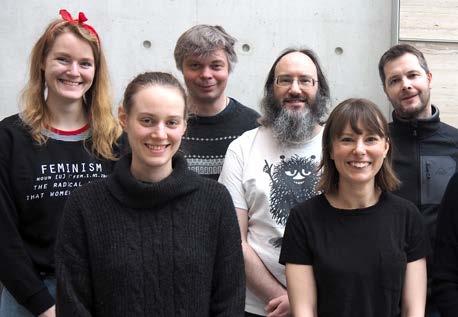
Major sCientifiC ContriButions
The PhD thesis of Sam Perrin was submitted in October 2020 and successfully defended January 2021 (Perrin 2021). The thesis focuses around constructing the basis of a modelling framework that will forecast likely establishments of non-native species in freshwater ecosystems and their impacts on freshwater fish communities. In order to achieve this, questions regarding the potential effects that the combined anthropogenic factors of climate change and non-native species will have on freshwater ecosystems were explored.
In the paper “Integrating dispersal along freshwater ecosystems into species distribution models” (Perrin et al. 2020) from the thesis, the ability of species distribution models to account for dispersal is investigated. Accounting for such dispersal in SDMs has usually been accomplished through the integration of population connectivity. However for this to be effective, connectivity parameters need to have a sufficiently tangible link to the relevant species’ dispersal capacity. For example, the linear distance “as the crow flies” is unlikely to be a good indicator of dispersal for freshwater fish species. Freshwater fish depend upon dendritic waterways where dispersal possibilities upstream are determined by terrain topography. To investigate the effect of different connectivity measures, recolonization of fish into lakes previously treated with the piscicide rotenone was used as a historical experiment to determine dispersal capacity. Further, a Joint Species Distribution Model (JSDM) was used to account for environmental and connectivity variables while simultaneously estimating biotic associations between species using a detailed dataset on fish presence / absence in the Kautokeino watershed in northern Norway. Inclusion of connectivity parameters improved our JSDM, suggesting that carefully considered connectivity metrics can improve the ability to model species, future distributions. This is likely to be of particular importance when assessing effects of land use impacts or restoration efforts, such as dam construction or removal, on the spread of invasive freshwater species or on the ability of native species to track thermal habitat alterations caused by climate change. Changing climate is also likely to modify interactions in waters where species currently coexist, potentially allowing one species to outcompete or increase predation pressure on
Figure Location of sites used in research article Integrating dispersal along freshwater ecosystems into species distribution models, which makes up chapter two of this thesis. Locations are freshwater lakes which have been treated with rotenone in Sweden (purple) and surveyed lakes within the Kautokeino watershed in northern Norway (green).
Arctic charr (Salvelinus alpinus). Photo: Anders G. Finstad

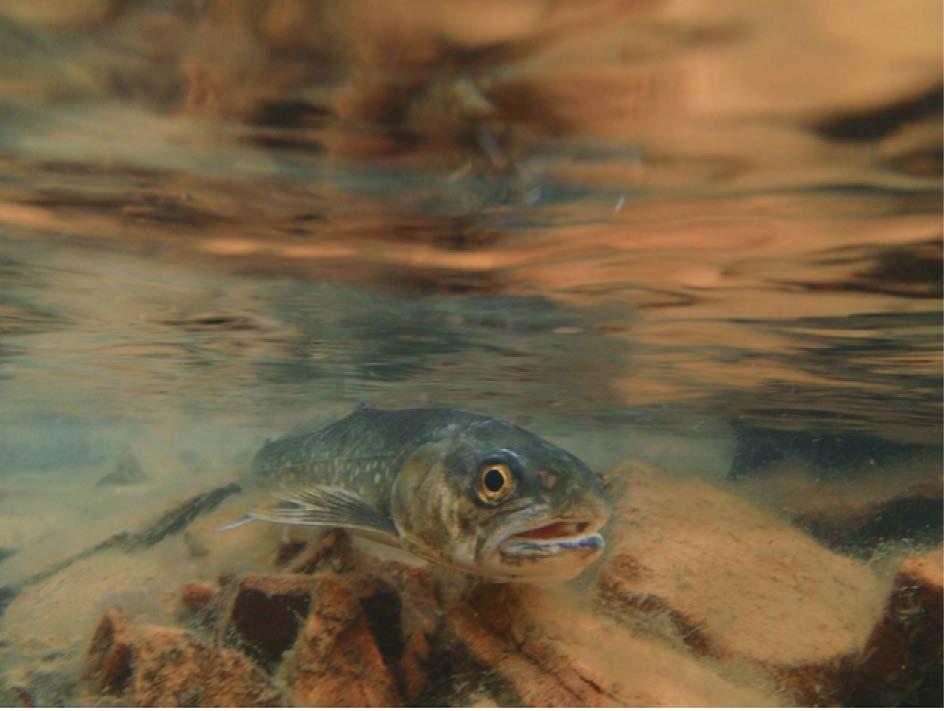
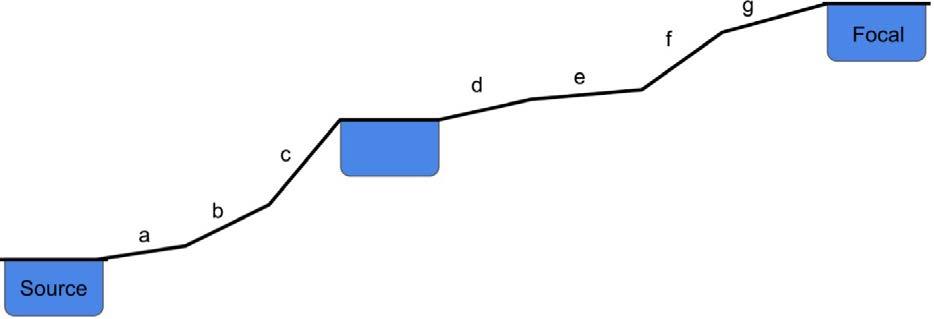
Figure Visual representation of different slope measurements of the pathway between a downstream (source) lake and an upstream (focal) lake. In this case, the slope is broken up into 7 “pixels” across two stream “sections,” with the sections separated in this case by an intermediary lake. The slope of each pixel is represented by the letters a-g. Slope characteristics of the full pathway are calculated by aggregating characteristics of the sections by mean weighted by section length (for slope mean, third quartile and maximum) or by the maximum of the sections (for absolute maximum). For example, third quartile of the slope is calculated using the average third quartile of both sections, weighted by stream length (in this case (f × 4 + b × 3)/7). Absolute maximum slope is calculated by taking the maximum of the two stream sections’ maximum slopes (in this case c)
the other. With regard to scandinavian freshwaters, we may in the future expect increased negative associations between cold-tolerant species like arctic charr and species tolerant of warmer waters, particularly perch, roach and pike. Accordingly, species distribution models also need to incorporate species associations and how these change with a changing climate. RECOMMENDED READING:
Perrin, SW, Englund, G, Blumentrath, S, Brian O’Hara, R, Amundsen, P-A, Gravbrøt Finstad, A. Integrating dispersal along freshwater ecosystems into species distribution models. Divers Distrib. 2020; 26: 1598– 1611. https://doi.org/10.1111/ ddi.13112 Perrin, S. W., & Norges teknisk-naturvitenskapelige universitet Institutt for biologi. (2021). Freshwater fish community responses to climate change and invasive species (Vol. 2021:27). Norwegian University of Science and Technology, Faculty of Natural Science, Department of Biology.
researCh group: DynaMiCs of arCtiC eCosysteMs
Current group members: PI: Professor Brage Bremset Hansen Senior researcher Vebjørn Veiberg (NINA) Postdoc Bart Peeters Postdoc Mathilde Le Moullec PhD candidate Kate Layton-Matthews PhD candidate Laura Bartra Cabré
Aim: Our research applies demographic modelling and multi-species stochastic approaches to understand how environmental change and trophic interactions influence population and community dynamics, as well as eco-evolutionary dynamics, in time and space
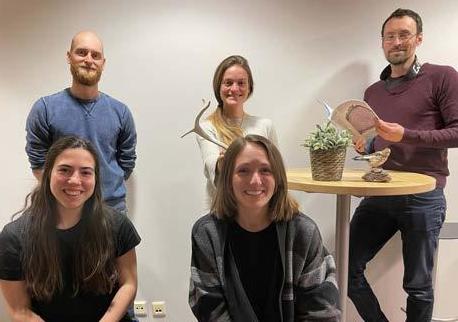
Bart Peeters, Mathilde Le Moullec, Brage Bremset Hansen Laura Bartra Cabré, Kate Layton-Matthews
Photo: Per-Harald Olsen
Major sCientifiC ContriButions
The project INSYNC (Research Council Norway, 2018-2022) uses novel field-experimental approaches and demographic time-series analyses to explore how climate drivers of key ecosystem components shape spatiotemporal dynamics of the tundra community in Svalbard. Collaborators include Univ. Aberdeen (UK), Univ. Groningen (NL), Univ. Iceland, CNRS Montpellier (FR), Norwegian Meteorological Institute, and the Univ. Centre in Svalbard.
Interactions between harvest and climate change
We are particularly interested in understanding and predicting how impacts of climate change may interact with other natural or anthropogenic drivers of ecological and evolutionary dynamics. In Peeters et al. 2020, we demonstrated important consequences of overharvesting (causing regional extirpations), human-made reintroduction programs and sea-ice loss for the current population genetics of Svalbard reindeer (Figure 1). These anthropogenic drivers appear to interact, such that the effects of past regional extirpations due to overharvest are modified by recent lack of sea-ice (an important dispersal corridor), thereby restricting recolonization, delaying largescale population recovery, and limiting gene flow. Such links between spatiotemporal population dynamics and ecoevolutionary dynamics are key to predict future consequences of climate change and, therefore, a focal topic in our research plan. Figure 1 (Peeters et al. 2020): Bayesian clustering analyses of Svalbard reindeer spatial population genetics revealed six clusters (K = 6). This figure maps the genetic structure at 25 sampling sites (pie charts increasing in size relative to number of sampled individuals n), indicating strong interactive effects of past overharvest (local extirpations), reintroduction programs and recent climate change (loss of sea-ice as dispersal corridor).
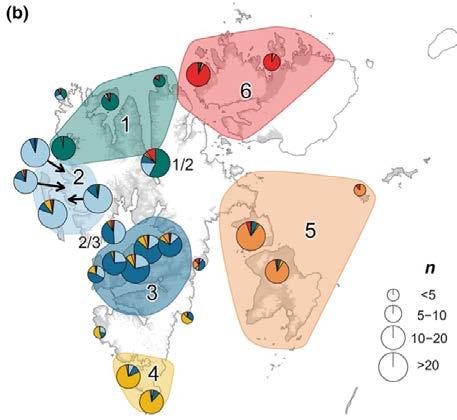
Spatial population synchrony
We have recently been focusing on how weather events and climate change impact larger-scale patterns of population dynamics, notably the level and scaling of spatial population synchrony. In a paper by Le Moullec et al. 2020, we used dendrochronology to investigate how weather and climate impact shrub growth across Svalbard (Figure 2). Fluctuations in summer temperature largely explained annual shrub growth across the archipelago and, thereby, contributed significantly to spatially synchronous growth over large distances. On the contrary, negative impacts of occasional large-scale rain-onsnow events on shrub growth were only evident in some coastal regions, acting as a potentially de-synchronizing agent on large spatial scales. In such a bottom-up regulated trophic system, the level and scaling of spatial co-fluctuations in plant growth may have implications for spatiotemporal community-level dynamics. However, we have shown that the annual population fluctuations of the main herbivore, the Svalbard reindeer, are mainly driven by density-dependent effects of winter harshness (rain-on-snow events and icelocked pastures), while bottom-up effects of e.g. warmer summers and increased plant growth can be more delayed, operating through the long-term carrying capacity K. Annual variation in rain-on-snow events thus contribute to spatially synchronous reindeer population size fluctuations from year to year, whereas gradual ‘Arctic greening’ and longer snow-free seasons cause similar long-term trends in abundance among populations (Hansen et al. 2020).
Considering the general importance of the Moran effect (i.e. the impact of large-scale weather fluctuations and climate on spatial population co-fluctuations) and the fact that spatial Figure 2 (Le Moullec et al. 2020): Fluctuations in July temperature largely explain annual ring growth in the dwarf shrub Salix polaris across the Svalbard archipelago, and thereby contribute significantly to a largescale spatial synchrony in primary production, with potential implications for the whole tundra community.
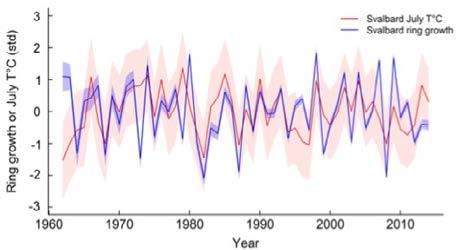
population synchrony patterns are crucial for long-term extinction risks, surprisingly few studies have investigated how climate change may influence population synchrony. In a paper receiving the runner-up prize in the E4 Awards (Ecography Excellence in Ecology and Evolution), we reviewed the existing literature and outlined, through simple population modelling and simulations, different potential pathways through which global warming may significantly alter patterns of spatial synchrony (Hansen et al. 2020). A key result was that changes in both the mean, variability and spatial autocorrelation of weather can impact population synchrony over time (Figure 3). This is particularly likely under a ‘generalized Moran effect’, i.e. when relaxing Moran’s strict assumption of identical log-linear density-dependence, which is highly unrealistic in the wild.
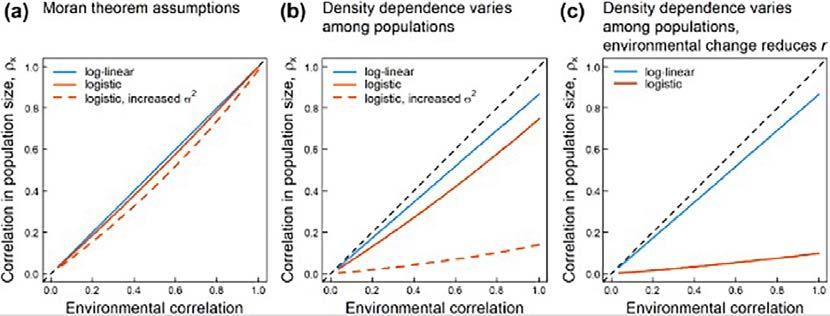
Figure 3 (Hansen et al. 2020, Ecography): From our theoretical population model we see, in accordance with Moran’s theorem, that given equal log-linear density dependence among populations, the correlation in abundances (i.e. population synchrony) will be equal to the correlation in the environment (panel a). Importantly, for nonlinear dynamics, the correlation in abundances is always less than that of the environment (panels a, b, c). With variation in density dependence among populations in the nonlinear logistic model, the magnitude of this reduction will depend on β1, β2, σ2 and environmental correlation ρe (panel b).
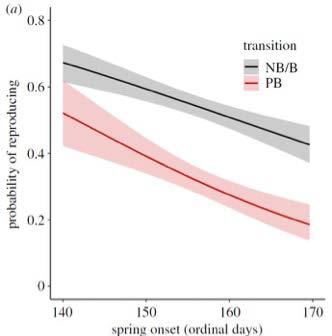
Figure 4 (Fjelldal et al. 2020): The later the spring onset, the less likely that barnacle geese in Ny-Ålesund, Svalbard, breed. This effect is particularly strong in ‘pre-breeders’ (PB; individuals that never bred before), resulting in a long-term temporal trend in age of first reproduction as the advancement of the timing of spring onset proceeds under climate warming.
Furthermore, climate change can influence spatial population synchrony indirectly, through its effects on dispersal and species interactions. Because changes in population synchrony may cascade through food-webs, we argue that the (generalized) Moran effect is key to understanding and predicting impacts of global warming on large-scale ecological dynamics, with implications for extinctions, conservation and management. Spatial population synchrony under changing environments is therefore one of our current focal areas of research.
Eco-evolutionary dynamics in barnacle geese
Kate Layton-Matthews’ PhD project has contributed to great progress in our understanding of eco-evolutionary implications of climate change and trophic interactions in Arctic geese. For instance, a rapidly advancing timing of spring onset has overall positive effects on reproduction in barnacle geese (LaytonMatthews et al. 2020), and even causes earlier age of first reproduction (Fjelldal et al. 2020) with potential evolutionary consequences. However, this effect on egg laying is offset by increased predation of fledglings by Arctic foxes (LaytonMatthews et al. 2020). As part of Laura Bartra Cabré’s current PhD project we are now using a combination of empirical and theoretical work to investigate whether such strong trophic links may lead to cascading effects of climate change across whole communities. RECOMMENDED READING:
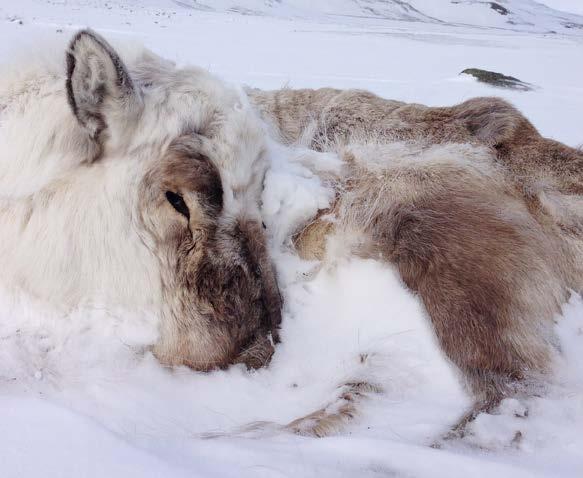
Fjelldal MA, Layton-Matthews K, Lee AM, Grøtan V, Loonen MJJE & Hansen BB (2020). High-Arctic family planning: earlier spring onset advances age at first reproduction in barnacle geese. Biology Letters 16:20200075. Hansen BB, Pedersen ÅØ, Peeters B, Le Moullec M, Albon SD, Grøtan V, Herfindal I, Sæther B-E & Aanes R (2020). Spatial heterogeneity in climate change effects decouples the longterm dynamics of wild reindeer populations in the high Arctic. Global Change Biology 25:3656-3668. Hansen BB, Grøtan V, Herfindal I & Lee AM (2020). The Moran effect revisited: spatial population synchrony under global warming. Ecography 43: 1591-1602. Layton-Matthews K, Hansen BB, Grøtan V, Fuglei E & Loonen MJJE (2020). Contrasting consequences of climate change for migratory geese: Predation, density dependence and carryover effects offset benefits of high-arctic warming. Global Change Biology 26:642-657. Le Moullec M, Sandal L, Grøtan V, Buchwal A & Hansen BB (2020). Climate synchronises shrub growth across a highwarctic archipelago: contrasting implications of summer and winter warming. Oikos 129:1012-1027. Peeters, B, Le Moullec M, Raeymaekers JAM, Marquez JF, Røed KH, Pedersen ÅØ, Veiberg V, Loe LE & Hansen BB (2020). Sea ice loss increases genetic isolation in a high Arctic ungulate metapopulation. Global Change Biology 26:2028-2041.
researCh group: DynaMiCs of interaCting speCies
Current group members: PI: Associate Professor Aline Magdalena Lee Researcher Elena Albertsen (NIBIO) Postdoc Marie Vestergaard Henriksen (NIBIO) PhD candidate Jonatan Fredricson Marquez PhD candidate Ragnhild Bjørkås
Aim: To understand stochastic population dynamics in the presence of species interactions, using a combination of theoretical modeling and data analysis.
We work in the gap between classical single-species population ecology and community ecology, studying the dynamics of interacting species in fluctuating environments. We are interested in how interacting species covary in space and time, and how their dynamics are driven by combinations of factors, such as life history, spatial movement, characteristics of their interactions, and different types of environmental stochasticity. Our work involves a combination of theoretical modeling and empirical data analysis. Aline Magdalena Lee, Elena Albertsen, Marie Vestergaard Henriksen, Jonatan Fredricson Marquez, Ragnhild Bjørkås
Major sCientifiC ContriButions
This year we have been joined by new PhD candidate Ragnhild Bjørkås who is studying the role of interspecific interactions in determining spatio-temporal population dynamics under shared environmental variation. Focusing on the avian community of the Serengeti, she aims to increase our understanding of the processes and mechanisms behind this interspecific population synchrony.
Species interactions influence global warming effects
Shared environmental conditions and fluctuations are known to synchronize population dynamics in what is commonly called the Moran effect. When populations are synchronized over large areas, the overall (meta-)population becomes more sensitive to unexpected environmental events and extinction. In Hansen et al. (2020) we explore how global warming might change population synchrony. Species interactions provide several pathways for such changes (Figure 1). For example, global warming is causing changes in community composition through species extinctions and range shifts. Because predation and competition both influence the population synchrony of the interacting species, such changes are likely to alter the population synchrony of many species within affected communities. This paper was selected as 1st Runner-Up for the Ecography E4 award for Excellence in Ecology and Evolution.
Age-dependent patterns of spatial synchrony in three marine fish species
Species can exhibit distinct patterns of spatial synchrony in their abundance dynamics due to differences in processes such as dispersal rates, environmental sensitivity and trophic interactions. These processes can also vary greatly between the age classes of a population, which led to the question, does spatial synchrony vary between the age classes of a population? Using data from three marine fish species cohabiting in the Barents Sea we found that spatial autocorrelation could vary between age classes in some species, however, the variation with age was not consistent among species. We found that spatial synchrony increased with age in cod, decreased with age in beaked redfish and stayed constant between the age classes of haddock (Figure 2). In addition, we found that in the cases of haddock and cod
Figure 1. Direct and indirect pathways through which climate change might affect population synchrony. In addition to direct effects through changes in the intrinsic population growth rate r, carrying capacity K, environmental variance σ2 and correlation in environmental noise ρe, there are many possible indirect effects, and species interactions play a central role in several of these.
Direct climate change effects
Changes in mean environment
Changes in temporal environmental variability
Changes in spatial environmental synchrony ����2
Changes in population synchrony Indirect climate change effects
Habitat fragmentation
Dispersal rate
Distribution of competitors
Synchrony of trophically interacting species Changes in mean environment
Changes in temporal environmental variability
Changes in spatial environmental synchrony
Figure 2. Decay of autocorrelation in density, ρ, with increased distance for three species of marine fish. The green dashed lines represent the spatial autocorrelation of the population density, while the solid dark and light blue lines represent the autocorrelation of the density of juveniles and adults, respectively. Smoothers represent the 95% intervals obtained from parametric bootstrap analyses.
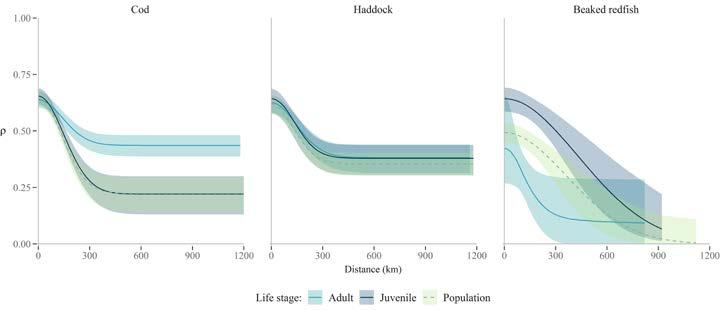
Figure 3. Spatial distribution of plants (circles) within the patch coloured according to sub-group (i.e. module in the network). In the best fit models (3% best indices), bumblebee foraging choice was highly dependent on the distance to nearby plants. This resulted in spatially distinct sub-groups of plants that were visited by the same bumblebee individuals and aligned with the spatial grouping of plants in the empirical data.
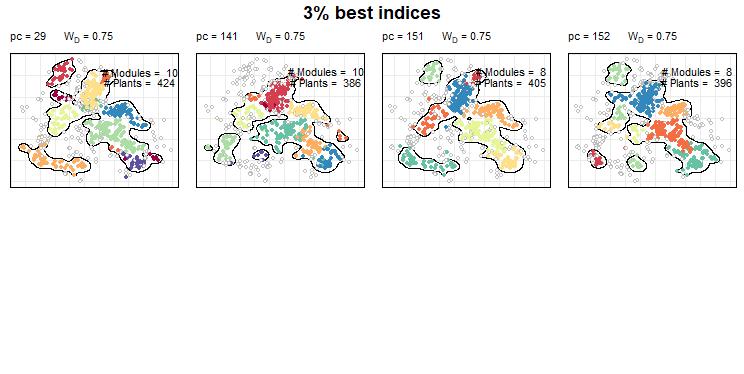
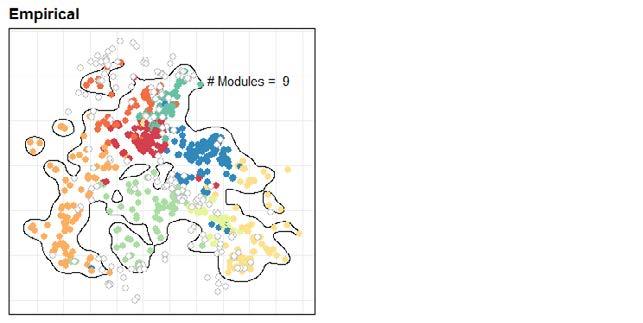
the spatial autocorrelation patterns of older age classes were partly explained by the density distribution of the cohort during the previous year. Our results indicate that differences in life history strategies between species play an important role in the spatial autocorrelation pattern of individual age classes. In addition, since different age classes can have different spatial autocorrelation, changes in age structure could indirectly alter the spatial synchrony pattern of the entire population. These differences among species in the patterns and underlying mechanisms of population synchrony could play a major role in how communities respond to environmental change.
Plant-pollinator interactions: do plant characteristics influence bumblebee movement?
Plant-pollinator interactions are crucial elements of many natural communities and gaining a better understanding of these interactions is essential for sustainable management. In Chudzinska et al. (2020), we investigated the movement patters of a pollinator to determine what influences their choices when moving from flower to flower within a patch of resources. We used a combination of agent-based modelling and network statistics to evaluate how small-scale, within-patch movement decisions of the bumblebee Bombus pascuorum are related to plant characteristics and the spatial distribution of resources. A key advantage of combining ABM and network statistics is the ability to capture emergent properties of animal movement using relatively simple and transparent sets of rules governing individual behaviours. Thus, we used network statistics to compare emergent patterns from the model with those derived from empirical data. Our results showed that local movement patterns of bumblebees can be modelled using simple foraging rules based on the spatial arrangement of flowers. Thus, distance to nearby plant was by far the most important factor in determining flower choice. Preference for neighbouring plants resulted in spatially distinct sub-areas within the patch that were repeatedly visited by the same set of bumblebee individuals (Figure 3). RECOMMENDED READING:
Lee, A.M., Sæther, B.-E. and Engen, S. 2020. Spatial covariation of competing species in a fluctuating environment. Ecology 101, e02901. Hansen, B.B., Grøtan, V., Herfindal, I. and Lee, A.M. (2020), The Moran effect revisited: spatial population synchrony under global warming. Ecography, 43: 1591-1602 Chudzinska, M., Dupont, Y.L., Nabe-Nielsen, J., Maia, K.P., Henriksen, M.V., Rasmussen, C., Kissling, W.D., Hagen, M., Trøjelsgaard, K. 2020. Combining the strengths of agentbased modelling and network statistics to understand animal movement and interactions with resources: example from within-patch foraging decisions of bumblebees. Ecological Modelling, 430, 109119, https://doi.org/10.1016/j. ecolmodel.2020.109119.





